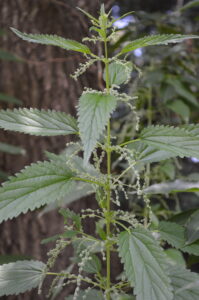
Stinging nettles have hairs along the stem and leaves that act like tiny needles and irritate the skin. (photo/Cindy Hadish)
Some gardeners value stinging nettles for their use in tea and natural remedies for conditions such as arthritis, allergies and diabetes.
The leaves, stems and roots are also edible, but should never be eaten raw, due to the stinging hairs on the plant.
For those who see stinging nettles as more “foe” than “friend,” removing them can be risky.
The stinging hairs act like tiny needles, feeling akin to a bee sting, and inject histamine into the skin that causes irritation, which can last 24 hours or more.
Remedies include washing with soap and water and applying a paste of baking soda. Antihistamines also can be used, while folk remedies including the use of dock leaves to relieve irritation.
Caution should be taken when hand-pulling the plants, as the hairs can even pierce leather gloves, but the entire plant and its roots need to be removed if you don’t want the plants to return.
Learn how weeds can be beneficial to bees.


No Comments Yet